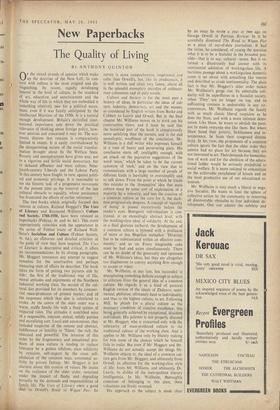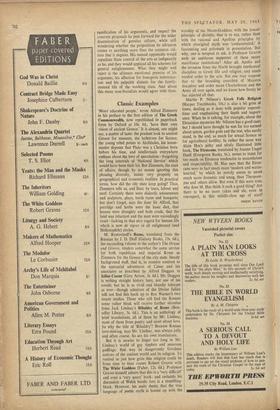New Paperbacks The Quality of Living
BY ANTHONY QUINTON OF the mixed strands of opinion which make up the doctrine of the New Left, its con- cern with culture is the most original and dis- tinguishing. Its recent, rapidly developing interest in the level of culture, in the standard of art, education and entertainment and the whole way of life in which they are embedded is something relatively now for a political move- ment, even if it was faintly anticipated by the intellectual Marxism of the 1930s. It is a natural enough development. Britain's shrivelled inter- national importance cuts down the practical relevance of thinking about foreign policy, how- ever anxious and concerned it may be. The eco- nomic distress that remains is comparatively limited in extent. It is easily overshadowed by .the disappointing nature of the social transfor- mation brought about by the Welfare State. Poverty and unemployment have given way, not to a vigorous and fertile social democracy, but to debased affluence and mass culture. Nine- teenth-century Liberals and the Labour Party in this century have fought, in turn, against politi- cal and economic privilege. It is reasonable to see the historic task of a progressive movement at the present time as the removal of the last cultural obstacle to equality, whose persistence has frustrated the efforts of earlier reformers. The two books which originally focused this interest in culture, Richard Hoggart's The Uses of Literacy and Raymond Williams's Culture and Society, 1780-1950, have been reissued as Paperbacks (Pelican, 4s. and 4s. 6d.). This event appropriately coincides with the appearance in the series of Fabian tracts of Richard Woll- heim's Socialism and Culture (Fabian Society, 4s. 6d.), an eraborate and detailed criticism of the point of view they have inspired. The Uses of Literacy is descriptive and critical, it offers no recommendations. In its closing paragraphs, Mr. Hoggart renounces any attempt to suggest remedies for the unattractive and perhaps menacing state of affairs he describes. The book takes the form of putting two pictures side by side: the first of the traditional way of life, moral attitudes and enjoyments of the Northern industrial working class, the second of the cul- tural diet provided for its members by commer- cial mass-producers of printed matter, and of the responses which that diet is calculated to evoke. At the centre of the older order was a warm, stalile family life with a fixed system of respected roles. The attitudes it nourished were of a responsible, tolerant, stoical, mildly puritan and moralising sort. Local and autonomous, they included suspicion of the remote and abstract, indifference or hostility to `Them,' the rich, the educated and powerful. The invasion of this order by the fragmentary and sensational pro- ducts of mass culture is tending to replace tolerance by a gutless nihilism, class solidarity by cynicism, self-respect by the crass self- adulation of the common man, communal ac- tivity by private fantasy. Mr. Hoggart is not alarmist about this erosion of values. He insists on the resilience of the older order, sustained under the impact of flashy and degrading triviality by the demands and responsibilities of family life. The Uses of Literacy owes a good deal to Orwell's Road to Wigan' Pier. Its
survey is more comprehensive, impersonal and calm than Orwell's, but. like its predecessor, it is well written and often very funny, above all in the splendid exemplary parodies of ordinary- man columnists and of pulp novels.
Culture and Society is for the most part a history of ideas, in particular the ideas of cul- ture, industry, democracy, art and the masses, as considered by English writers from Burke and Cobbett to Leavis and Orwell. But in the final chapter Mr. Williams moves onto work out his constructive views, and it must be said that the historical part of the book is conspicuously more satisfying than the earnest, and in the end apocalyptic, woolliness of the conclusion. Mr.
Williams is a dull writer who expresses himself in a tone of heavy and persevering piety. His conclusion starts off, intelligibly enough, with an attack on the pejorative suggestions of the word 'mass,' which he takes to be the current synonym of 'mob,' and on the view that to communicate, with a large number of people of different kinds is inevitably to oversimplify and to talk down. From the point at which he traces this mistake to the 'dominative' idea that mass culture must be some sort of exploitation of a majority by a minority, and secs the creation of a common culture as the cure for it, the dark- ness progressively deepens. A concept of 'equality of being' is passed mysteriously before the reader's eyes. Bourgeois individualism is con- trasted, at an exceedingly abstract level, with the working-class ideal of solidarity. At the end, in a final glorious outburst, the development of a common culture is hymned with a profusion of more or less Hegelian metaphor. 'Diversity has to be substantiated within an effective com- munity,' and so on. Every imaginable cake must be had and eaten simultaneously. There can be no doubt of the generosity and openness of Mr. Williams's ideas, but they are altogether too diaphanous to convey anything firm enough to accept or reject.
Mr. Wollheim, at any rate, has succeeded in precipitating something definite enough to subject to criticism from the general idea of a common culttire. He regards it as a kind of pastoral English version of the ideals of Zhdanov, senti- mental, philistine, ultimately fatal to individuality and thus to the highest culture, to art. Following Mill, he pleads for a plural culture as the necessary condition of creative excellence. this being generally achieved by exceptional, dissident individuals. His polemic is not properly directed at Mr. Hoggart, who is concerned only with the inferiority of mass-produced culture to the traditional culture of the working class. And it applies to Mr. Williams only by bluntly making for him some of the choices which he himself fails to make. But even if Mr. Hoggart and Mr.
Williams do not actually accept the things Mr. Wollheim objects to, the ideal of a common cul- ture gets from Mr. Hoggart, and ultimately from Orwell, its affection for the working-class style of life; from Mr. Williams, and ultimately Dr.
Leavis, its dislike of the metropolitan literary intelligentsia. In Mr. Wollheim, thoroughly conscious of belonging to this class, these valuations are firmly reversed.
His approach to the subject is made clear by an essay he wrote a year or two ago on George Orwell in Partisan Review. In it he scornfully dismissed The Road to Wigan Pier as a piece of out-of-date journalism. It had the virtue, he considered, of raising the question what it is to be a Socialist in the broadest pos- sible—that is to say, cultural—terms. But it re- turned a disastrously bad answer with its sentimental adulation of working-class life. A harmless passage about a working-class domestic scene is set about with something like venom and described as crude sentimentality. The plain fact is that Mr. Hoggart's older order makes Mr. Wollheim's gorge rise. Its admirable soli- darity will be superfluous in a Socialist society, when 'They' are no longer on top, and its suffocating cosiness is undesirable in any cir- cumstances. Mr. Wollheim regards the family with as much classic liberal suspicion as he does the State, and with a more intimate detes- tation. Like Shaw, he wants to abolish the poor, not to make everyone else like them. But where Shaw hated their poverty, fecklessness and in- temperance, he hates their congested domes- ticity. In his view,.the proponents of a common culture ignore the fact that the older order they admire had no place for art because they are not interested in art. Their demands for humanisa- tion of work and for the abolition of the educa- tional ladder would be seriously prejudicial to social welfare. It is more rational to concentrate on the achievable ,enrichment"of leisure and on the most productive use of our educational re- sources.
Mr. Wollheim is very much a liberal or nega- tive Socialist. He wants to limit the sphere of collective action by the community to removing all discoverable obstacles to free individual de- velopment. One can admire the subtlety and ramification of his arguments, and respect the concrete proposals he puts forward for the wider dissemination of genuine culture, while still wondering whether the proposition he advances comes to anything more than the common cul- ture that it negates. His named opponents would repudiate State control of the arts as indignantly as he, and they would applaud all his schemes for general enlightenment. What they might well reject is the ultimate emotional premise of his argument, his affection for bourgeois bohemian- ism and his palpable distaste for the family- centred life of the working class. And about this many non-Socialists would agree with them.















































 Previous page
Previous page